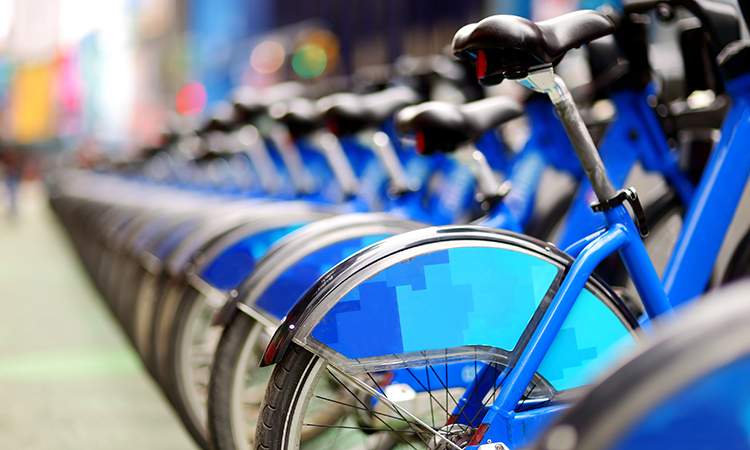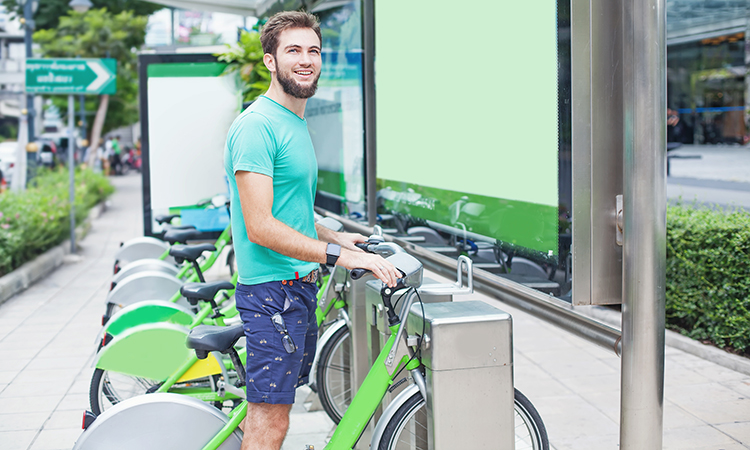Embracing micro-mobility innovation to reduce energy consumption and congestion in large cities
- Like
- Digg
- Del
- Tumblr
- VKontakte
- Buffer
- Love This
- Odnoklassniki
- Meneame
- Blogger
- Amazon
- Yahoo Mail
- Gmail
- AOL
- Newsvine
- HackerNews
- Evernote
- MySpace
- Mail.ru
- Viadeo
- Line
- Comments
- Yummly
- SMS
- Viber
- Telegram
- Subscribe
- Skype
- Facebook Messenger
- Kakao
- LiveJournal
- Yammer
- Edgar
- Fintel
- Mix
- Instapaper
- Copy Link
Posted: 13 June 2022 | Alisyn Malek - Coalition for Reimagined Mobility | No comments yet
Alisyn Malek, Executive Director at the Coalition for Reimagined Mobility, stresses the urgent need to adopt alternative modes of mobility to the private car in order to support the fight against emissions and congestion, and details the role that micro-mobility will play in delivering the effective and efficient multimodal transport systems that will be vital to achieving ambitious climate goals.


Picture this: it’s lunch time, and you go out to grab food. It’s too far to walk, so you hop on an electric scooter located on the sidewalk that fronts your apartment building. When you leave the restaurant, you decide to place your food in the basket attached to an e-bike and ride back to the office. Congratulations! You successfully completed a trip using transportation options other than a four-wheel passenger vehicle. These micro-mobility options, which include two- and three-wheelers, will help us to decrease congestion in urban centres, reduce global carbon emissions and meet urgent climate goals.
Yes, the electrification of cars will play an important role in the fight against carbon emissions, but there are other, better options for a number of applications that consume less energy and deliver greater convenience”
We (particularly in the West), need to understand that not every person – or every trip – requires four wheels. This is true even if those vehicles are electric. Yes, the electrification of cars will play an important role in the fight against carbon emissions, but there are other, better options for a number of applications that consume less energy and deliver greater convenience.
Not to mention that many of those better options can be leveraged now in our urgent fight against emissions and congestion. Recent Intergovernmental Panel on Climate Change (IPCC) climate data also sheds light on the need for better mobility options to limit air pollution and promote wellbeing. Micro-mobility is a great solution for achieving both. And, according to Joyashree Roy, an economist at the Asian Institute of Technology in Bangkok, “people are demanding more healthy cities and greener cities.”
Micro-mobility: Understanding the benefits (if we work together)
One night in 2018, Lime dropped 200 scooters on the streets of Honolulu, Hawaii. Just as quickly, the police carted off 81 of the bright green scooters, alleging that the company used city property without authorisation. In Bournemouth, UK, a similar story: months after introducing an e-scooter programme, the police seized 25 private scooters for riding on public land. Often, to break into a market, e-scooter companies ask for forgiveness, rather than permission. Are local governments against micro-mobility options, or does an education gap exist about these modes of transportation?
By educating people about the environmental benefits of micro-mobility solutions and their more efficient use of land than passenger cars, companies can work in concert with governments to deploy the scooters, e-bikes and other modes of micro-mobility transportation that are so necessary to reduce traffic congestion and emissions in cities”
By educating people about the environmental benefits of micro-mobility solutions and their more efficient use of land than passenger cars, companies can work in concert with governments to deploy the scooters, e-bikes and other modes of micro-mobility transportation that are so necessary to reduce traffic congestion and emissions in cities. The math equation is already there for options beyond four-wheel passenger vehicles for these use cases: less mass, less energy, cleaner and less congested cities. This public and private partnership is critical if we’re to realise the potential of mobility options.
Furthermore, micro-mobility options can bridge current transportation gaps that are both expensive and cumbersome to solve, while limiting or reducing emissions at the same time. For example, India has permitted parking space for electric bikes in Delhi, Bangalore, Pune, Mumbai and Ahmedabad. The result? People outside of reasonable walking distance from public transportation have access to a safe, efficient and environmentally friendly option to move around. This reduces congestion and emissions caused by four-wheel passenger vehicles. Ola is an Indian micro-mobility provider addressing this transport accessibility gap by providing multimodal mobility access to 100 million people through two-wheelers. Their expansion into e-scooters is addressing congestion and emissions now, while other solutions get built for the future.


The rise of sustainable micro-mobility
As the COVID-19 outlook improves, we have begun emerging from our COVID cocoons – not necessarily to travel to the office, but to grab lunch with friends. Many people still feel apprehensive about public transportation and, therefore, are choosing to use micro-mobility options, like scooters or bikes, instead. Moreover, as awareness about – and calls to address – the climate crisis moves to the forefront of the global agenda, citizens, organisations and public agencies are taking a keener interest in finding solutions to lowering greenhouse gas (GHG) emissions.
When one transport option becomes less viable, such as petrol-powered cars that emit pollutants and depend on increasingly more expensive fuel, other options to get from A to B become more attractive”
This is why multimodality is so important: when one transport option becomes less viable, such as petrol-powered cars that emit pollutants and depend on increasingly more expensive fuel, other options to get from A to B become more attractive. Today, cities like Boston, Seattle and London, which originally banned scooters, are reintroducing these modes of transportation.
What happened? With the added demand for scooters as a regular transportation option, cities are finally addressing gray areas that exist, such as how to classify them and where users can ride them. In the UK, new regulations allowing trials of rental e-scooters, originally planned for 2021, were enacted in July 2020. Positioned as a way to “boost the green recovery from the pandemic and to help mitigate the impacts of the ongoing climate crisis,” according to the UK Department for Transport (DfT), the programme aims to do more than just provide alternative transportation options, addressing climate goals in the process. This is a perfect example of where electrifying cars was not (and is not) the answer alone. Smaller, simpler, alternative modes of transportation are baked into the future of mobility as a part of the UK’s ‘green recovery’.
If you’re in the city, why take a four-wheel vehicle trip when you can likely travel more conveniently using a smaller modality? Why deal with traffic congestion or expensive parking when a micro-mobility option like an e-scooter may make more sense for your trip?


The key to micro-mobility: Public-private partnerships
The public and private transport sectors loosely share the same goal: offering transport options that are safe, efficient and readily available – and that support a healthier, more sustainable world. The latter goals around reducing emissions and energy efficiency have quickly become front-and-center. But disagreement lies in how to introduce and implement micro-mobility options, and even what their role should be in the broader transportation ecosystem. Private companies often focus on innovation and the profitability of a product or service, while cities consider how they can serve their entire population safely and affordably.
Private companies and local governments must work together to encourage appropriate use of micro-mobility services”
Private companies and local governments must work together to encourage appropriate use of micro-mobility services. Recent implementations in New York City are a good example of this. City officials installed more protected bike lanes, launched a public education campaign about which types of e-mobility devices are legal, set strict safety guidelines and are closely monitoring the city’s first e-scooter pilot programme. The public-private pilot programme put riders’ needs first, which, in-turn, benefits the environment by reducing barriers to new habits that lower emissions.
Beyond docking stations, city infrastructure plans must support micro-mobility as a means to greener or carbon-neutral communities. This will make new modes of transportation more attractive for residents. We don’t need to start from scratch. We can take hints from cities like Amsterdam and reconsider the design of the urban core.
Amsterdam’s model was born under similar circumstances: the 1973 oil crisis quadrupled the price of oil. That led the Prime Minister of the Netherlands to ask that Dutch citizens adopt a new lifestyle and get serious about saving energy. 22,000 miles of new cycling paths encouraged people to hop on bikes and choose their own path. Now, more than a quarter of all trips in the Netherlands are made by bicycle. By contrast, it’s two per cent in the UK.
Now is the time for cities to build or reimagine infrastructure that accommodates pedestrians, bikes, scooters, cars and public transit in a harmonious way”
Now is the time for cities to build or reimagine infrastructure that accommodates pedestrians, bikes, scooters, cars and public transit in a harmonious way. Public transit alone cannot serve today’s transportation needs due to the rise and dispersion in population, and car-centric models cannot help us to meet urgent climate goals. Let’s use what we already have, such as existing lanes for cars, and repurpose them so that they can be used for micro-mobility modes.
Reaching the destination of the future with micro-mobility
Let’s revisit our “day in the life” one more time. It’s 2030, and you’re wrapping up a day of work at the office. You leave the building and use your local transit card to grab a bike within steps of the office entrance. You ride home in the designated bike lane, passing pedestrians on wide sidewalks, full electric buses carrying passengers and a few cars on the road. You’re doing your part to reduce carbon emissions. And, thanks to everyone else participating in this effort, the air is cleaner and our climate goals are within much closer reach than they once were. This future can be enabled through micro-mobility, where people choose bikes and scooters without even thinking about it, mostly because it’s a simpler, easier-to-use alternative.
Alisyn Malek is a change maker in the mobility and automotive sectors. With over 12 years of experience in leading organisations, driving investments and developing products, Malek has played an active role in tackling complex challenges head on and offering effective solutions.
Currently, Malek is the Executive Director for the Coalition for Reimagined Mobility, which aims to reshape transportation policy globally across environmental, safety and economic opportunity considerations to achieve stronger outcomes.
Related topics
Air Quality, Alternative Power, Infrastructure & Urban Planning, Mobility Services, Multimodality, Passenger Experience, Public Transport, Sustainable Urban Transport, Traffic Management
Related modes
Bikes & Scooters
Related organisations
Coalition for Reimagined Mobility, Department for Transport (DfT), Intergovernmental Panel on Climate Change (IPCC), Lime
Related people
Alisyn Malek








